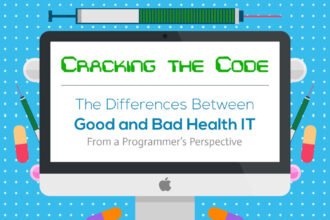Managing hospitals and clinics comes with challenges related to patient safety and proper care. Patients, especially those suffering from dementia, tend to wander around the facility, often get lost, or fail to come in for procedures on time. The busy staff can’t always keep track of a patient, which sometimes leads to unpleasant and even dangerous incidents. That’s when patient tracking systems come in handy. These tools are based on RTLS (Real-time Locating Systems) and are an affordable digital solution that’s easy to implement and manage in hospitals of all sizes.
What is RTLS & How it works
RTLS (Real-time Locating Systems) is a real-time positioning system. With special equipment, RTLS-based systems instantly determine the location of an object and track its movement on a digital map. Using this data, you can quickly find a patient inside the hospital or prevent them from leaving the territory.
The system is characterized by high flexibility and great opportunities in terms of implementation. It can be easily adapted to fit almost any monitoring task while using minimal costs. RTLS patient tracking allows you to constantly monitor the movement of patients, which increases their safety level and provides better care.
The key benefits of patient tracking systems are:
- effective search for patients throughout the hospital;
- real-time tracking;
- visibility at the level of a given zone;
- quality management of patient care (quick medical assistance based on push notifications);
- making more efficient management decisions based on monitoring and improved analytics.
How it works
The work process of the patient location tracking system is based on beacons placed in the building and wearable equipment for patients (e.g. badges, cards, smart watches, etc.). As soon as the person with the tag begins to move, the tag immediately sends out radio signals that contain a specific identification number. These impulses are captured by readers and transmitted to a special web platform for further processing. Finally, the data about the patient location is sent to smartphones or desktop computers that belong to the staff.
Technologies and equipment to implement the tracking system
To implement patient location tracking at the hospital, you need several components, including special software, sensors/tags, and readers. The number of equipment required depends on the needs of the medical institution and is determined by its area, the technology you choose, and the complexity of the system.
There are many ways to implement RTLS tracking, but the most common are the following technologies:
- Bluetooth® Low Energy: a wireless technology based on Bluetooth® LE. The range of the system is up to 320 ft, and the location of objects is determined with an accuracy of up to 3 ft.
- Wi-Fi: this one can be implemented in the existing infrastructure and works via access points that transmit their identifiers using special signaling packets. Provides an accuracy of up to 10-16 ft. In recent years, its more modern version known as Wi-Fi RTT has gained popularity too – this one allows you to determine the location with an accuracy of fewer than 3 ft.
How can a patient tracking system help hospitals?
Constantly monitoring the movement of patients helps the management improve the quality of service at a medical institution. Now, you can make staying at the hospital safer, increase the efficiency of staff, and get detailed analytics to optimize the workflow of the clinic.
Improving the safety of difficult patients
Even within hospitals, some patients are exposed to high risk. This applies to difficult patients with dementia, Alzheimer’s, and other disorders that cause an increased tendency to wander. They need constant monitoring since such a person can quietly leave the medical institution and find themselves in a dangerous situation.
RTLS-based hospital patient tracking systems allow you to track difficult patients and quickly respond to their movements. After implementing this technology, you can:
- determine the patient location in real time;
- control their movement around the hospital;
- detect attempts to exit the territory of a medical institution;
- receive notifications in case of emergency;
- build the shortest routes to the patient to quickly get them back to their room.
If needed, the patient can use their bracelet with a tag to call a doctor or nurse. The equipment works as a “panic” button and allows you to provide timely medical assistance.
Improving the efficiency of staff work
Patient tracking systems significantly increase the efficiency of the staff. Thanks to them, there’s no need for nurses to constantly be near a patient or accompany them around the hospital since all movements are displayed on the digital hospital map. If a patient didn’t return to their room on time or didn’t come in for their procedures at a specific time, it’s enough to find out their current location to respond to a possible emergency immediately.
If needed, the system can send various push messages to staff. For example, a hospital is divided into several access zones that a patient may or may not visit. As soon as they wandered into the area where they shouldn’t be, a notification immediately pops up on the nurse’s smartphone. This is especially important when caring for patients who suffer from Alzheimer’s or dementia.
Using different technologies gives different levels of accuracy in determining the location of the patient. The hierarchy could be as follows:
- precisely calculating the location of patients within the hospital;
- determining the location at the room level (where in the room is the person, how much time the nurse spends with a particular patient, etc.);
- searching within the boundaries of a given zone (floor, building, wing);
- at the points of entry and exit from each zone.
A high level of accuracy is considered especially beneficial for medical institutions, which allows you to find a person within up to 2 ft from the sensors. In combination with real-time positioning, this helps increase the quality of service, improve workflow, and minimize unnecessary tasks.
Obtaining analytical reports to optimize the work process at the facility
The RTLS patient tracking system provides improved analytics on the facility. Using it, the management can determine a wide range of data, such as:
- COVID-19 contact tracing;
- the busiest areas of the hospital;
- waiting time for a doctor or a specific procedure;
- the duration of stay at the hospital;
- the time that the patient spent receiving treatment, etc.
It’s also important that a detailed analysis of activities allows for minimizing wasteful expenses. Statistically, most hospitals buy up to 10-20% more portable equipment than needed. This is simply so that the staff can urgently find equipment when they need it. But if you implement RTLS location tracking, you can quickly find equipment on digital maps and reduce the number of excess assets.
To sum up, patient location tracking in hospitals is an effective solution to improve safety at the facility. The introduction of hospital patient tracking systems into the infrastructure allows for minimizing the number of wandering patients, ensuring their protection, and improving the management quality.

_9_2-250x220.jpg)





